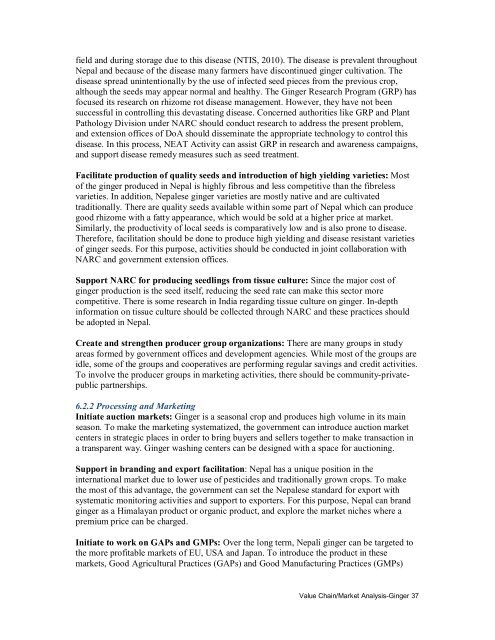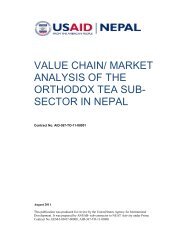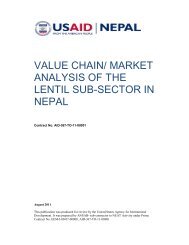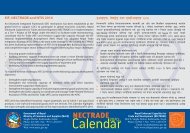value chain/ market analysis of the ginger sub-sector ... - Nepal Trade
value chain/ market analysis of the ginger sub-sector ... - Nepal Trade
value chain/ market analysis of the ginger sub-sector ... - Nepal Trade
- No tags were found...
You also want an ePaper? Increase the reach of your titles
YUMPU automatically turns print PDFs into web optimized ePapers that Google loves.
field and during storage due to this disease (NTIS, 2010). The disease is prevalent throughout<strong>Nepal</strong> and because <strong>of</strong> <strong>the</strong> disease many farmers have discontinued <strong>ginger</strong> cultivation. Thedisease spread unintentionally by <strong>the</strong> use <strong>of</strong> infected seed pieces from <strong>the</strong> previous crop,although <strong>the</strong> seeds may appear normal and healthy. The Ginger Research Program (GRP) hasfocused its research on rhizome rot disease management. However, <strong>the</strong>y have not beensuccessful in controlling this devastating disease. Concerned authorities like GRP and PlantPathology Division under NARC should conduct research to address <strong>the</strong> present problem,and extension <strong>of</strong>fices <strong>of</strong> DoA should disseminate <strong>the</strong> appropriate technology to control thisdisease. In this process, NEAT Activity can assist GRP in research and awareness campaigns,and support disease remedy measures such as seed treatment.Facilitate production <strong>of</strong> quality seeds and introduction <strong>of</strong> high yielding varieties: Most<strong>of</strong> <strong>the</strong> <strong>ginger</strong> produced in <strong>Nepal</strong> is highly fibrous and less competitive than <strong>the</strong> fibrelessvarieties. In addition, <strong>Nepal</strong>ese <strong>ginger</strong> varieties are mostly native and are cultivatedtraditionally. There are quality seeds available within some part <strong>of</strong> <strong>Nepal</strong> which can producegood rhizome with a fatty appearance, which would be sold at a higher price at <strong>market</strong>.Similarly, <strong>the</strong> productivity <strong>of</strong> local seeds is comparatively low and is also prone to disease.Therefore, facilitation should be done to produce high yielding and disease resistant varieties<strong>of</strong> <strong>ginger</strong> seeds. For this purpose, activities should be conducted in joint collaboration withNARC and government extension <strong>of</strong>fices.Support NARC for producing seedlings from tissue culture: Since <strong>the</strong> major cost <strong>of</strong><strong>ginger</strong> production is <strong>the</strong> seed itself, reducing <strong>the</strong> seed rate can make this <strong>sector</strong> morecompetitive. There is some research in India regarding tissue culture on <strong>ginger</strong>. In-depthinformation on tissue culture should be collected through NARC and <strong>the</strong>se practices shouldbe adopted in <strong>Nepal</strong>.Create and streng<strong>the</strong>n producer group organizations: There are many groups in studyareas formed by government <strong>of</strong>fices and development agencies. While most <strong>of</strong> <strong>the</strong> groups areidle, some <strong>of</strong> <strong>the</strong> groups and cooperatives are performing regular savings and credit activities.To involve <strong>the</strong> producer groups in <strong>market</strong>ing activities, <strong>the</strong>re should be community-privatepublicpartnerships.6.2.2 Processing and MarketingInitiate auction <strong>market</strong>s: Ginger is a seasonal crop and produces high volume in its mainseason. To make <strong>the</strong> <strong>market</strong>ing systematized, <strong>the</strong> government can introduce auction <strong>market</strong>centers in strategic places in order to bring buyers and sellers toge<strong>the</strong>r to make transaction ina transparent way. Ginger washing centers can be designed with a space for auctioning.Support in branding and export facilitation: <strong>Nepal</strong> has a unique position in <strong>the</strong>international <strong>market</strong> due to lower use <strong>of</strong> pesticides and traditionally grown crops. To make<strong>the</strong> most <strong>of</strong> this advantage, <strong>the</strong> government can set <strong>the</strong> <strong>Nepal</strong>ese standard for export withsystematic monitoring activities and support to exporters. For this purpose, <strong>Nepal</strong> can brand<strong>ginger</strong> as a Himalayan product or organic product, and explore <strong>the</strong> <strong>market</strong> niches where apremium price can be charged.Initiate to work on GAPs and GMPs: Over <strong>the</strong> long term, <strong>Nepal</strong>i <strong>ginger</strong> can be targeted to<strong>the</strong> more pr<strong>of</strong>itable <strong>market</strong>s <strong>of</strong> EU, USA and Japan. To introduce <strong>the</strong> product in <strong>the</strong>se<strong>market</strong>s, Good Agricultural Practices (GAPs) and Good Manufacturing Practices (GMPs)Value Chain/Market Analysis-Ginger 37






